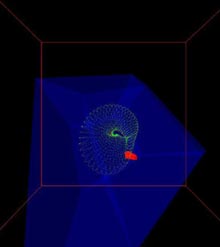Physicist Drops Work Experience Kids into a 4 Dimensional Hypercube

A two dimensional picture of a 4D Hypercube <br>© Warwick University Press Office
When you are sent to do a bit of work experience in the office of a university science department you don’t normally expect much more than a bit of boring filing and some tedious photocopying. So those that turned up to the University of Warwick’s Physics department recently were a bit shocked to be taken to a small black room and dropped into a virtual reality four dimensional hypercube.
Instead of dreary photocopying the work experience kids were used to help University of Warwick physicist Richard Wellard solve the major problem of how to rotate a four dimensional object- a hyper cube- in the three dimensions of a virtual reality simulator.
Everyone has seen the classic two dimensional wire frame drawing of a three dimensional cube. It is also even possible to produce a two dimensional picture of a 4D Hypercube (it looks like a cube within a cube). However until now researchers have found it difficult to get their three dimensional virtual reality systems to display and rotate a 4D dimensional hypercube without straining the viewer’s understanding of how to manipulate the image well beyond the ability of most people.
Richard Wellard’s new system allows simple movements of a virtual reality wand to rotate 4D hypercubes with such ease that it took only an hour to train, the quiet literally inexperienced, work experience kids to rotate the 4D hypercube in precise ways.
Why would anyone want to rotate a 4D hypercube anyway? Richard Wellard believes it will be an invaluable tool for anyone trying to explain, teach or research the difficult field of 4 dimensional objects such as the Klein bottle – a one-sided closed surface that cannot be constructed in normal space. It is most commonly pictured as a cylinder looped back through itself to join with its other end.
It will also prove useful to anyone trying to find patterns in data which involves plotting four different variables. Researchers will be able to use virtual reality systems to plot such data on a four dimensional virtual reality graph which they can then rotate to search for patterns in the data.
For further details contact:
Richard Wellard
email: Wellard@astro.warwick.ac.uk
Dept of Physics, University of Warwick
Tel: 07985 377718
Media Contact
All latest news from the category: Physics and Astronomy
This area deals with the fundamental laws and building blocks of nature and how they interact, the properties and the behavior of matter, and research into space and time and their structures.
innovations-report provides in-depth reports and articles on subjects such as astrophysics, laser technologies, nuclear, quantum, particle and solid-state physics, nanotechnologies, planetary research and findings (Mars, Venus) and developments related to the Hubble Telescope.
Newest articles

Making diamonds at ambient pressure
Scientists develop novel liquid metal alloy system to synthesize diamond under moderate conditions. Did you know that 99% of synthetic diamonds are currently produced using high-pressure and high-temperature (HPHT) methods?[2]…

Eruption of mega-magnetic star lights up nearby galaxy
Thanks to ESA satellites, an international team including UNIGE researchers has detected a giant eruption coming from a magnetar, an extremely magnetic neutron star. While ESA’s satellite INTEGRAL was observing…

Solving the riddle of the sphingolipids in coronary artery disease
Weill Cornell Medicine investigators have uncovered a way to unleash in blood vessels the protective effects of a type of fat-related molecule known as a sphingolipid, suggesting a promising new…





















